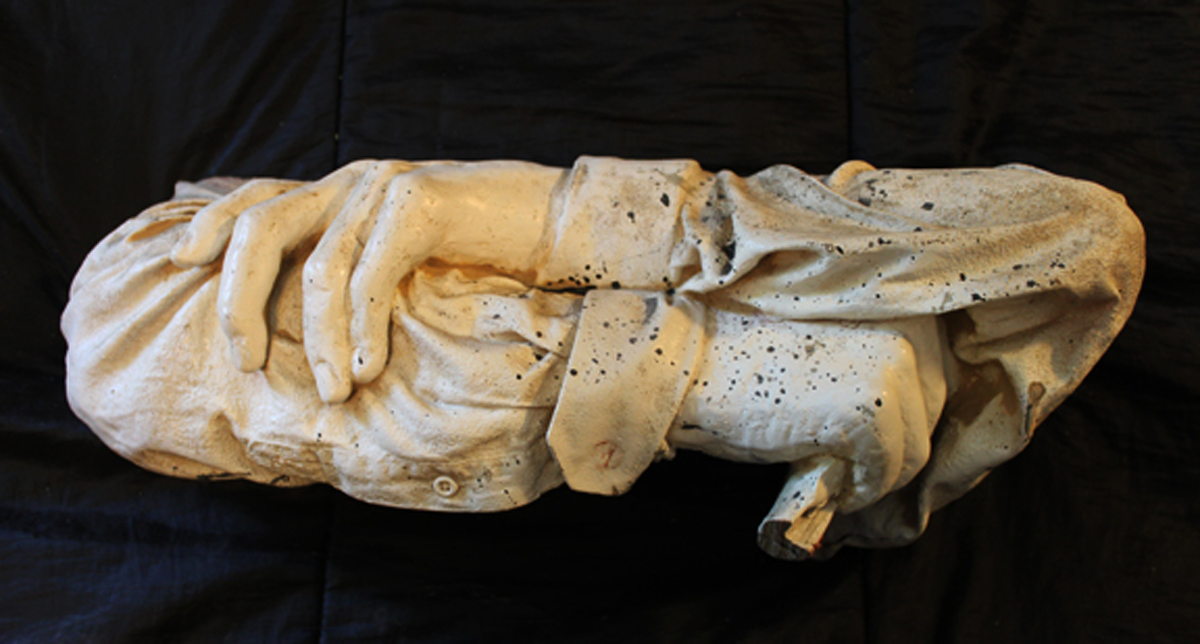
The Hands of John Muir
For a project to commemorate the new millennium in the year 2000, I decided to learn how to build a website. For years I had been making photograph albums of my travels and building projects, and hauling them out to illustrate my storytelling. With the invention of the website and the simple HTML code, I could put all those albums online and make them available to people at long distance, or I could make them appear on the screens at any home I was visiting. It also could serve as a portfolio of my work for a prospective client.
And that's the way it worked out. By 2006, I had quite an elaborate site, with pictures of our trips to Nepal, Bali and Costa Rica; the skateboard parks in Santa Barbara and Ventura; a fabulous Sebastopol estate in old growth recycled redwood, etc., and strategic keywords that would lead the curious to take a look.
Among the pages I had posted was the replacing of Carol's driveway in Petaluma. Her house is just a few hundred yards from the Petaluma River in the low bottomland of a broad valley. The ground underneath these houses is river clay, which shrinks during times of dryness or drought, and in the rainy season swells up significantly. The result is that all the concrete driveways on this moving terrain are cracked and buckled; and Carol's was very much an unsightly jigsaw of broken slabs.
The solution was to tear out the existing and replace with a heavily reinforced surface that would have a fake flagstone pattern in it that would conceal the inevitable cracks in a random field. It came out great and now years later the idea has proven itself.
A man named Bill Stockton was searching for someone to help him do a fancy patio surface at his house in Sebastopol. He googled: "Sonoma County stamped concrete", and up popped my website. He got in touch.
Carol's driveway came out beautifully. a good thing since I would be looking at it for the rest of my life. So much could have gone wrong that didn't go wrong, that, true to my practice in many dimensions, I had resolved to quit while I was ahead. I told Bill that I didn't want to attempt that professionally because I figured I had used up my beginner's luck. He responded by inviting me out to talk about doing a bunch of other projects. He hadn't made up his mind anyway about how the patio was going to be. He had looked around on my website and the kinds of projects I had done; skateparks, hot tubs, a yurt in Big Sur, a redwood mansion, and the name of my website reminded him of a Grateful Dead song.
He and his wife had recently moved onto an eight-acre chicken farm and apple orchard. It had two houses, four barns and some corrals and outbuildings. There was a lot to be done. He said he had about 18 months of miscellaneous improvements in mind. It turned out to be 3 years before we finished his list. Then I came back 5 years later and built two new houses for them.
Some of the first projects were the restoration and repurposing of the barns. One small red barn with a hayloft was the oldest building on the property, ca.1890. The rest of the buildings were built by the Matsuda family in 1948 or so. They had come to Sebastopol after being released from the WW II Internment camps, and set up a poultry business. There were two long barns that were for housing the chickens. The Matsuda's, being rather short people, had built them no higher than they needed to be, so that the lower chord of the triangular roof trusses came right about to the middle of our foreheads. That was inconvenient, and there was one crossing the barn every 12 feet.
Bill's wife is Ali Pearson. She is an accomplished muralist, specializing in the backdrops for the dioramas in natural history museums. She needed two of the spaces set up to do murals. My task was to eliminate the truss chords by adding ridge beams, so that she would have a place to make paintings that were 10 feet tall and 40 feet wide. With the "mural barn" accomplished, I moved on to repurpose the garage into a smaller mural space and studio where she did animal models and faux foliage. Sections of the other barns became a woodshop, metal shop, auto shop, spray booth and a "sculpture barn".
It hadn't been long before all these spaces were put to use. Ali had a great reputation and had created along with her friends major installations in museums and wildlife centers all over the country, and a few in foreign countries. While I was working there, she landed the contract to provide 19 murals with educational displays for the Visitor's Center in the middle of Yosemite Valley.
The whole project was more than Ali could do on her own, so she brought in close friends she had worked with in the past to help her with some of the painting and model making. Part of the commission was to produce a life size bronze sculpture of famed naturalist and Yosemite explorer John Muir, sitting on a boulder in the valley admiring the splendor of it all, in the pose of an iconic Ansel Adams photograph.
Ali's friend Bridget was the one with the chops to do the John Muir piece and she set to work in the sculpture barn. The method was surprising to me, and I was able to see what she had done day-to-day. She started with a foam dummy she dressed in hand sewn period clothes and lace up boots, just like the picture, and seated in that same posture. The sculpting of the head and face was done in clay with a felt hat. The clothing and hat were sprayed until soaked with an epoxy mixture to stiffen them. She tracked me down one day. "The hardest part is getting the hands just right", she said, taking my hands in hers. "I'd like to use plaster castings of yours"
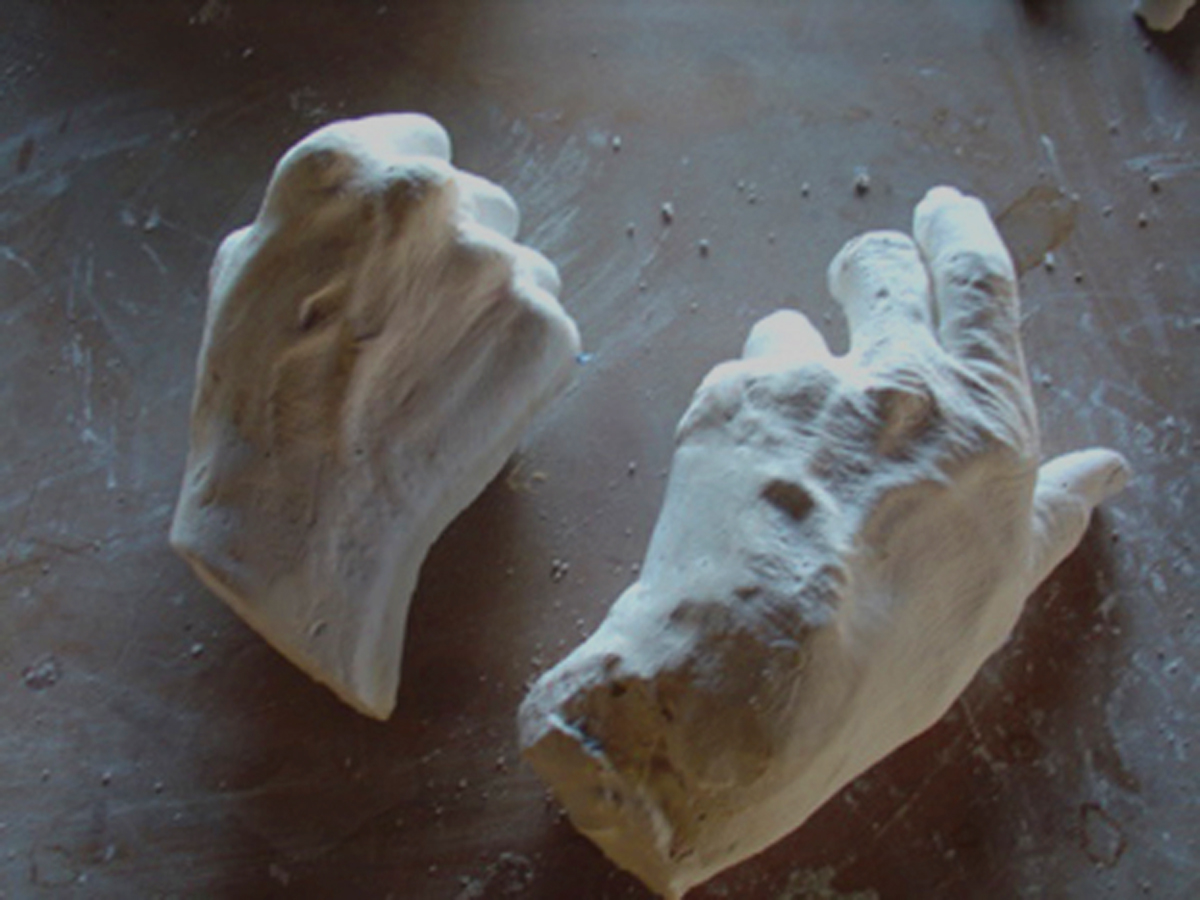
Well, I took that as a great honor, and a mold-making mixture was prepared, which I thrust my hands into, held in the manner of John Muir's photograph. In 30 seconds or so I popped them out of the molds and they were soon reproduced in plaster. They were attached to the rest of the sculpture, and the whole thing was transported to a foundry.
I regret not having gone to the foundry to witness the rest of the process, but as I understand it, the foam-cloth-clay and plaster creation is sawed into smaller pieces that are copied in a type of wax; assembled in to a wax duplicate that is packed in sand, then baked to let the wax drain out and followed by the pouring of molten bronze (the lost wax Process).
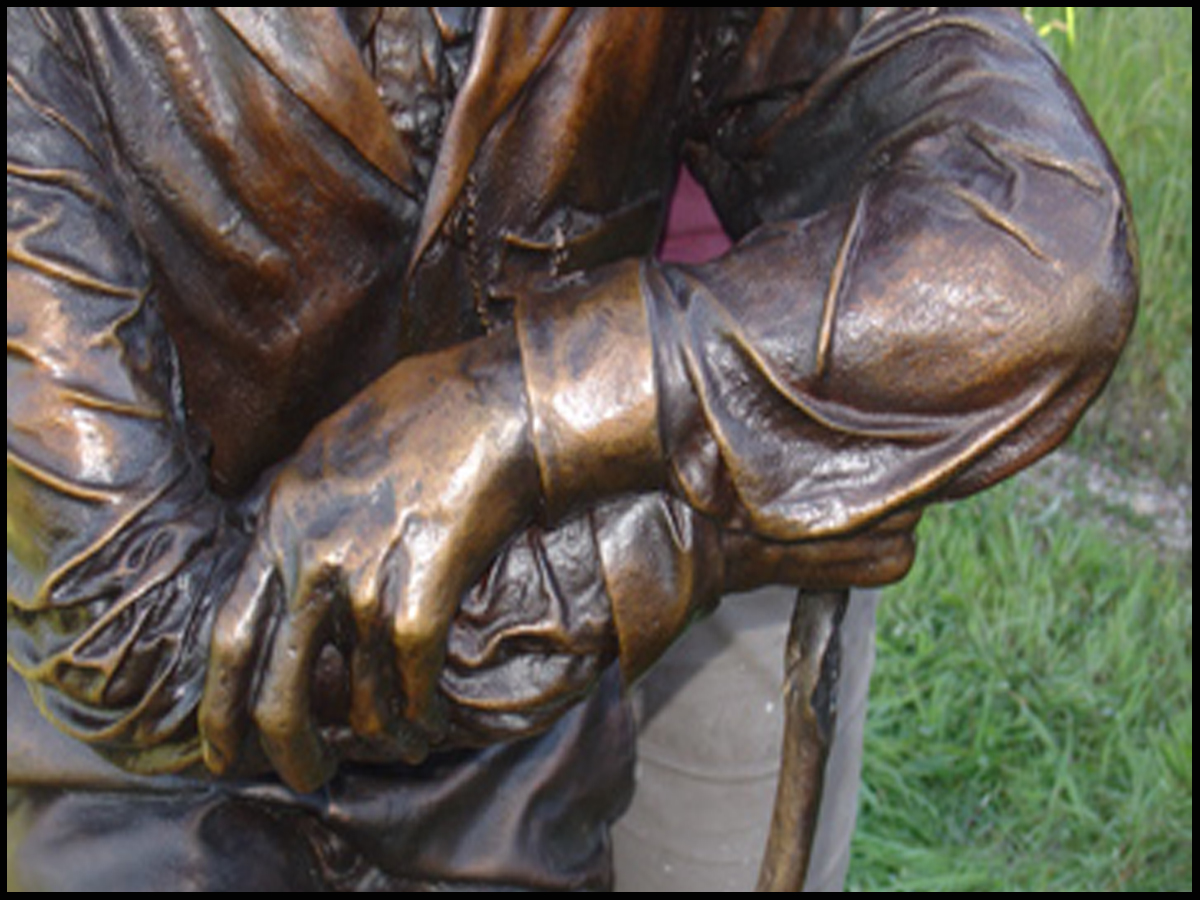
So there you have it; one of my undeserved claims to fame: my hands cast in bronze at the Yosemite Visitor Center. A few years later a second copy was poured and it can be found at the Visitor's Center at John Muir's Victorian house in Martinez, California.
Bridget presented me with the portion of the original that was the crossed arms and the hands of John Muir.

Not for sale. Uncle John's Garage Sale is just the name of the book.
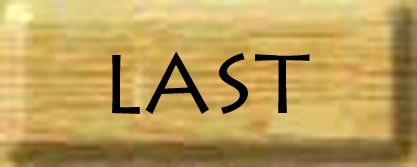

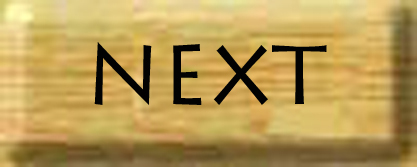
© 2022 John Oliver
All Rights Reserved
mail@unclejohnsweb.com
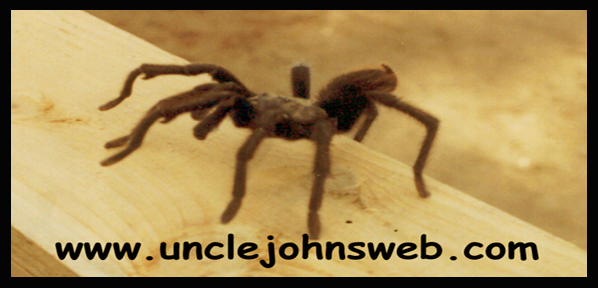
For a project to commemorate the new millennium in the year 2000, I decided to learn how to build a website. For years I had been making photograph albums of my travels and building projects, and hauling them out to illustrate my storytelling. With the invention of the website and the simple HTML code, I could put all those albums online and make them available to people at long distance, or I could make them appear on the screens at any home I was visiting. It also could serve as a portfolio of my work for a prospective client.
And that's the way it worked out. By 2006, I had quite an elaborate site, with pictures of our trips to Nepal, Bali and Costa Rica; the skateboard parks in Santa Barbara and Ventura; a fabulous Sebastopol estate in old growth recycled redwood, etc., and strategic keywords that would lead the curious to take a look.
Among the pages I had posted was the replacing of Carol's driveway in Petaluma. Her house is just a few hundred yards from the Petaluma River in the low bottomland of a broad valley. The ground underneath these houses is river clay, which shrinks during times of dryness or drought, and in the rainy season swells up significantly. The result is that all the concrete driveways on this moving terrain are cracked and buckled; and Carol's was very much an unsightly jigsaw of broken slabs.
The solution was to tear out the existing and replace with a heavily reinforced surface that would have a fake flagstone pattern in it that would conceal the inevitable cracks in a random field. It came out great and now years later the idea has proven itself.
A man named Bill Stockton was searching for someone to help him do a fancy patio surface at his house in Sebastopol. He googled: "Sonoma County stamped concrete", and up popped my website. He got in touch.
Carol's driveway came out beautifully. a good thing since I would be looking at it for the rest of my life. So much could have gone wrong that didn't go wrong, that, true to my practice in many dimensions, I had resolved to quit while I was ahead. I told Bill that I didn't want to attempt that professionally because I figured I had used up my beginner's luck. He responded by inviting me out to talk about doing a bunch of other projects. He hadn't made up his mind anyway about how the patio was going to be. He had looked around on my website and the kinds of projects I had done; skateparks, hot tubs, a yurt in Big Sur, a redwood mansion, and the name of my website reminded him of a Grateful Dead song.
He and his wife had recently moved onto an eight-acre chicken farm and apple orchard. It had two houses, four barns and some corrals and outbuildings. There was a lot to be done. He said he had about 18 months of miscellaneous improvements in mind. It turned out to be 3 years before we finished his list. Then I came back 5 years later and built two new houses for them.
Some of the first projects were the restoration and repurposing of the barns. One small red barn with a hayloft was the oldest building on the property, ca.1890. The rest of the buildings were built by the Matsuda family in 1948 or so. They had come to Sebastopol after being released from the WW II Internment camps, and set up a poultry business. There were two long barns that were for housing the chickens. The Matsuda's, being rather short people, had built them no higher than they needed to be, so that the lower chord of the triangular roof trusses came right about to the middle of our foreheads. That was inconvenient, and there was one crossing the barn every 12 feet.
Bill's wife is Ali Pearson. She is an accomplished muralist, specializing in the backdrops for the dioramas in natural history museums. She needed two of the spaces set up to do murals. My task was to eliminate the truss chords by adding ridge beams, so that she would have a place to make paintings that were 10 feet tall and 40 feet wide. With the "mural barn" accomplished, I moved on to repurpose the garage into a smaller mural space and studio where she did animal models and faux foliage. Sections of the other barns became a woodshop, metal shop, auto shop, spray booth and a "sculpture barn".
It hadn't been long before all these spaces were put to use. Ali had a great reputation and had created along with her friends major installations in museums and wildlife centers all over the country, and a few in foreign countries. While I was working there, she landed the contract to provide 19 murals with educational displays for the Visitor's Center in the middle of Yosemite Valley.
The whole project was more than Ali could do on her own, so she brought in close friends she had worked with in the past to help her with some of the painting and model making. Part of the commission was to produce a life size bronze sculpture of famed naturalist and Yosemite explorer John Muir, sitting on a boulder in the valley admiring the splendor of it all, in the pose of an iconic Ansel Adams photograph.
Ali's friend Bridget was the one with the chops to do the John Muir piece and she set to work in the sculpture barn. The method was surprising to me, and I was able to see what she had done day-to-day. She started with a foam dummy she dressed in hand sewn period clothes and lace up boots, just like the picture, and seated in that same posture. The sculpting of the head and face was done in clay with a felt hat. The clothing and hat were sprayed until soaked with an epoxy mixture to stiffen them. She tracked me down one day. "The hardest part is getting the hands just right", she said, taking my hands in hers. "I'd like to use plaster castings of yours"

I regret not having gone to the foundry to witness the rest of the process, but as I understand it, the foam-cloth-clay and plaster creation is sawed into smaller pieces that are copied in a type of wax; assembled in to a wax duplicate that is packed in sand, then baked to let the wax drain out and followed by the pouring of molten bronze (the lost wax Process).

Bridget presented me with the portion of the original that was the crossed arms and the hands of John Muir.

Not for sale. Uncle John's Garage Sale is just the name of the book.



© 2022 John Oliver
All Rights Reserved
mail@unclejohnsweb.com

All Rights Reserved
mail@unclejohnsweb.com
